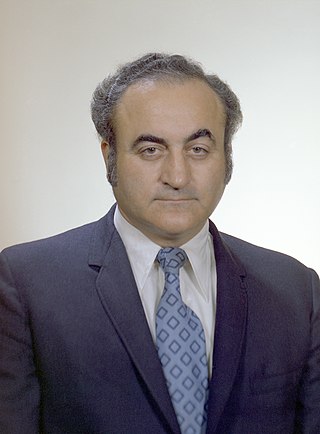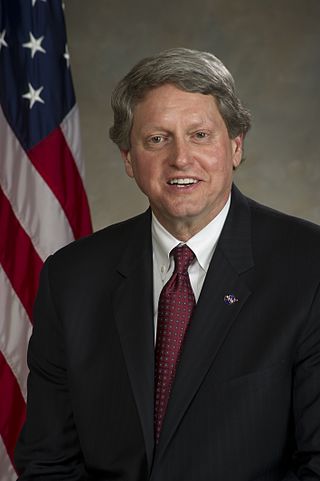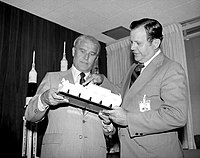
The George C. Marshall Space Flight Center (MSFC), located in Redstone Arsenal, Alabama, is the U.S. government's civilian rocketry and spacecraft propulsion research center. As the largest NASA center, MSFC's first mission was developing the Saturn launch vehicles for the Apollo program. Marshall has been the lead center for the Space Shuttle main propulsion and external tank; payloads and related crew training; International Space Station (ISS) design and assembly; computers, networks, and information management; and the Space Launch System (SLS). Located on the Redstone Arsenal near Huntsville, MSFC is named in honor of General of the Army George C. Marshall.

On January 28, 1986, the Space Shuttle Challenger broke apart 73 seconds into its flight, killing all seven crew members aboard. The spacecraft disintegrated 46,000 feet (14 km) above the Atlantic Ocean, off the coast of Cape Canaveral, Florida, at 11:39 a.m. EST. It was the first fatal accident involving an American spacecraft while in flight.

The Rogers Commission Report was written by a Presidential Commission charged with investigating the Space Shuttle Challenger disaster during its 10th mission, STS-51-L. The report, released and submitted to President Ronald Reagan on June 9, 1986, both determined the cause of the disaster that took place 73 seconds after liftoff, and urged NASA to improve and install new safety features on the shuttles and in its organizational handling of future missions.

Robert Laurel Crippen is an American retired naval officer and aviator, test pilot, aerospace engineer, and retired astronaut. He traveled into space four times: as pilot of STS-1 in April 1981, the first Space Shuttle mission; and as commander of STS-7 in June 1983, STS-41-C in April 1984, and STS-41-G in October 1984. He was also a part of the Manned Orbiting Laboratory (MOL), Skylab Medical Experiment Altitude Test (SMEAT), ASTP support crew member, and the Approach and Landing Tests (ALT) for the Space Shuttle.

The Space Shuttle Solid Rocket Booster (SRB) was the first solid-propellant rocket to be used for primary propulsion on a vehicle used for human spaceflight. A pair of these provided 85% of the Space Shuttle's thrust at liftoff and for the first two minutes of ascent. After burnout, they were jettisoned and parachuted into the Atlantic Ocean where they were recovered, examined, refurbished, and reused.

The Space Shuttle Pathfinder is a Space Shuttle test simulator made of steel and wood. Constructed by NASA in 1977 as an unnamed facilities test article, it was purchased in the early 1980s by the America-Japan Society, Inc. which had it refurbished, named it, and placed it on display in the Great Space Shuttle Exhibition in Tokyo. The mockup was later returned to the United States and placed on permanent display at the U.S. Space & Rocket Center in Huntsville, Alabama, in May 1988.
Thiokol was an American corporation concerned initially with rubber and related chemicals, and later with rocket and missile propulsion systems. Its name is a portmanteau of the Greek words for sulfur and glue, an allusion to the company's initial product, Thiokol polymer.

Roger Mark Boisjoly was an American mechanical engineer, fluid dynamicist, and an aerodynamicist. He is best known for having raised strenuous objections to the launch of the Space Shuttle Challenger months before the loss of the spacecraft and its crew in January 1986. Boisjoly correctly predicted, based on earlier flight data, that the O-rings on the rocket boosters would fail if the shuttle launched in cold weather. Morton Thiokol's managers decided to launch the shuttle despite his warnings, leading to the catastrophic failure. He was considered a high-profile whistleblower.

Alexander A. McCool Jr. was manager of the Space Shuttle Projects Office at the NASA George C. Marshall Space Flight Center in Huntsville, Alabama. During his career, McCool contributed to several space developments including the Apollo Program, Skylab and the Space Shuttle program.

Rocco Anthony Petrone was an American mechanical engineer, U.S. Army officer and NASA official. He served as director of launch operations at NASA's Kennedy Space Center (KSC) from 1966 to 1969, as Apollo program director at NASA Headquarters from 1969 to 1973, as third director of NASA's Marshall Space Flight Center from 1973 to 1974, and as NASA Associate Administrator from 1974 until his retirement from NASA in 1975.

James Robert Thompson Jr., known as J.R. Thompson, was the fifth director of the NASA Marshall Space Flight Center located in Huntsville, Alabama. He served as director from September 29, 1986, to July 6, 1989. Thompson also served as NASA's deputy director from July 6, 1989, to November 8, 1991.

Dr. Jerrol Wayne Littles was the eighth director of the NASA Marshall Space Flight Center located in Huntsville, Alabama. He served as director from February 3, 1996, to January 3, 1998.

Arthur G. Stephenson was the ninth Director of the NASA Marshall Space Flight Center located in Huntsville, Alabama. He served as director from September 11, 1998, to May 2003.

Axel Roth was born in Darmstadt, Germany, on October 25, 1936. He was the son of Ludwig Roth, an original member, of the German Rocket Team. He survived World War II, RAF bombing of rocket development facility at Peenemünde, Germany, August 17–18, 1943, known as Operation Crossbow. He arrived in the US in New York City, NY in 1946, a year after his father arrived there as part of Operation Paperclip, aboard a converted troop transport. He moved first to Ft. Bliss, Texas, and then to Huntsville, Alabama in 1950 when the German Rocket Team was relocated to Redstone Arsenal, Alabama.

Robert M. Lightfoot Jr. is former Acting Administrator of the National Aeronautics and Space Administration (NASA), serving from January 20, 2017 until April 23, 2018. Succeeding Charles Bolden, Lightfoot became the space agency's acting Associate Administrator on March 5, 2012. That job became permanent on September 25, 2012. He had previously served as the eleventh Director of the NASA Marshall Space Flight Center in Huntsville, Alabama, from March 2009 until his promotion in March 2012. On March 12, 2018 he announced his retirement from NASA effective April 30, 2018.

Arthur Eugene "Gene" Goldman is the executive director for Aerojet's Southeast Space Operations division. Before retiring from NASA in August 2012, he last served as acting director of the Marshall Space Flight Center located in Huntsville, Alabama. He was appointed as acting director effective March 5, 2012, following the promotion of the previous director, Robert M. Lightfoot, Jr., to Acting Associate Administrator of NASA.

Robin Neely Henderson is the Associate Director, Management, of the NASA Marshall Space Flight Center located in Huntsville, Alabama. She was named to become the center's Acting Director effective August 3, 2012, following the retirement of the previous director, Arthur E. Goldman, to take a private sector position. On September 25, 2012, NASA named Patrick Scheuermann as the center's new permanent director.

During the lifetime of the Space Shuttle, Rockwell International and many other organizations studied various Space Shuttle designs. These involved different ways of increasing cargo and crew capacity, as well as investigating further reusability. A large focus of these designs were related to developing new shuttle boosters and improvements to the central tank, but also looked to expand NASA's ability to launch deep space missions and build modular space stations. Many of these concepts and studies would shape the concepts and programs of the 2000s such as the Constellation, Orbital Space Plane Program, and Artemis program.

Heinrich Georg "Heinz" Struck was a German-American rocket scientist and member of the "von Braun rocket team." Struck worked in aerodynamics in both the private and federal sectors, particularly NASA, where he was recognized for his contributions to the Space Shuttle program.
George Landwehr von Pragenau was an Austrian-American engineer and rocket scientist. Brought to the U.S. by the Army for his work with transistors, he was heavily involved with the testing of the Saturn I and Saturn V rockets and the Space Shuttle. In 1985 he received NASA's Inventor of the Year Award for his work in stabilizing the Shuttle's fuel pumps.




















